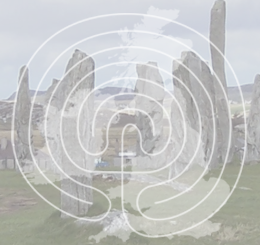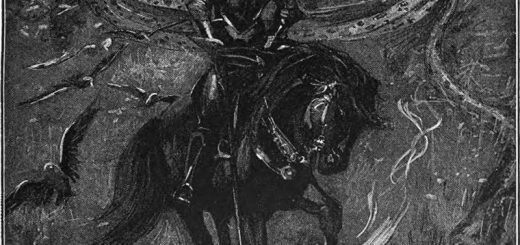St Moluag’s Church
This small and ancient church has a plethora of legends and traditions associated with it, making it one of the most important mysterious sites on the Isle of Lewis.
Archaeological evidence suggests that the church dates from the early 16th century, but its origins are believed to be more ancient, mainly due to the wealth of traditions and historical importance of the church. The church has a basic T shaped structure, with two small chapels on either side of the main body of the church. The southern chapel can only be accessed from outside, and its purpose is a mystery.
 There is a lot of speculation about the ancient origins of this place of worship; one tradition tells that St Ronan founded the church, before retiring to the Isle of Rona (in legend travelling on the back of a whale).
There is a lot of speculation about the ancient origins of this place of worship; one tradition tells that St Ronan founded the church, before retiring to the Isle of Rona (in legend travelling on the back of a whale).
The church, which had become a bare ruin in the 19th century was restored in 1912 by the Canon H.A. Meaden of the Episcopal church, and is now still in use as a Scottish Episcopal church.
The Legends of the Church and St Moluag
The church is dedicated to the shadowy figure of St Moluag, who is believed to have been a 6th century Irish missionary, although history records nothing of his deeds, and he may even be more of a mythical figure than a real person. St Moluag may in fact be one in the same with Lugaid of Lismore, who died in 592. Lismore is certainly an island associated with the saint as the following legend suggests.
Legend tells that St Columba and St Moluag had a rivalry to found a monastery on the island of Lismore, so they decided to settle it with a race to the island They set off but St Columba – a man of legendary feats – was soon in the lead, but just before he crossed the finish line, St Moluag chopped off his own finger and threw it ahead of him, thus winning the right to build his monastery.
One legend recorded in the 1860’s by Alexander Carmichael suggest that the church was built by the son of a Scandinavian king, who had converted to Christianity from his pagan ways. The Prince did not have roofing material, and his father’s longboats could not make the trip to Norway because of the stormy conditions. In desperation he prayed to God and his prayers were answered by a dream that told him to go to Stoth bay, as he would find a roof there. The next day he went to Stoth as the dream suggested, and found a roof floating in the water, which he used for the church.
The church also has a sighting legend, as it was once supposed to have been located on the western side of a small stream called Uisge na Comhraiche, which marked the boundary of a sacred enclosure created by the MacLeods. The sacred building was so outraged that the local matrons were spinning black wool late one Saturday night – that the building shifted to its present position on the eastern side of the stream.
The Healing Powers of the Church
One of the most enduring traditions associated with the church is its power as a place of healing, especially for those afflicted with mental problems. Many people were brought here in the hope of healing, and even those who could not reach the church sent wooden effigies of their afflicted parts. Captain Dymes who came to Lewis in 1630 recorded that people who could not visit the church “were wont to cut out the portion of their lame arms or legs in wood with the form of their sores and wounds therof and send them to the saint where I have seen them lying on the altar of the chapel.”*
 Dymes also described how the islanders met twice a year at the site for merry meeting, once at Candlemas on the 2nd of February and again at Halloween, although a local priest stopped this practice.
Dymes also described how the islanders met twice a year at the site for merry meeting, once at Candlemas on the 2nd of February and again at Halloween, although a local priest stopped this practice.
In 1862 Arthur Mitchell who was a lunacy inspector for Scotland recorded the following: “Lunatics are brought from many parts of the Northwest of Scotland to this ruin. One man who had been taken there, and whom I saw, had the good fortune to sleep and was cured. He afterwards married, and had a family. Seven years ago he again became insane, and I found him labouring under dementia.”
The Rev. Malcolm MacPhail – who was in Port of Ness in his youth – also recorded this practice in the 1890s, describing the church’s fame as a place for curing insanity, and that he knew of people who had been cured of insanity by sleeping within the confines of the church walls. The afflicted person was taken to the temple at dusk and made to “walk around the temple seven times ‘sunwise’ – ‘deiseil’ – and to drink water from the ‘holy well of the Teampull’, and was then freely besprinkled with the same water; but unless the patient slept after the treatment there could be no cure. I was slightly acquainted thirty-five years ago with the individual in question. He was then quite sane; and, as far as I know, was so ever afterwards.”
The well that was used in this ceremony is most likely to be Tobar Ronain, which is situated by the road at Eoropie. It is interesting to note that the container for the water used in the ceremony was in the custody of a family who were descendents of the ‘clerks of the temple’ suggesting a long tradition passed down a family line.
The church was still used for lunacy cures as late as the 19th century, when it was a roofless ruin.
Shony – The God of the Sea, a Pagan Survival?
Perhaps one of the most interesting stories and traditions associated with the church is its links with a god of the sea. If true the origins of this ceremony may be very old indeed, and may be a lost link with the practices of the pre-Christian islanders.
 Martin Martin (1695) described the ceremony in the one of the earliest written account of the church customs: “The inhabitants of this island had an ancient custom to sacrifice to a sea god called Shony at hallow tide…..The inhabitants came round to the church of St Mulvay…every family furnished a Peck of Malt, and this was brewed into Ale: one of their number was picked out to wade into the sea up to their middle, and carrying a cup of ale in his hand, standing still in that posture, cried out with a loud voice saying, Shony I give you this cup of ale, hoping that you’ll be so kind as to send us plenty of sea ware (seaweed), for enriching the ground the ensuing year. And so threw the cup of ale into the sea. This was performed at nightime.”*
Martin Martin (1695) described the ceremony in the one of the earliest written account of the church customs: “The inhabitants of this island had an ancient custom to sacrifice to a sea god called Shony at hallow tide…..The inhabitants came round to the church of St Mulvay…every family furnished a Peck of Malt, and this was brewed into Ale: one of their number was picked out to wade into the sea up to their middle, and carrying a cup of ale in his hand, standing still in that posture, cried out with a loud voice saying, Shony I give you this cup of ale, hoping that you’ll be so kind as to send us plenty of sea ware (seaweed), for enriching the ground the ensuing year. And so threw the cup of ale into the sea. This was performed at nightime.”*
They then returned to the church and proceeded to party in the fields outside the church walls, this was after a period of solomn silence within the church. The most likely location for the offering to Shony is at Stoth bay, which is well sheltered, and relatively close to the church.
*Spelling corrected to aid reading
Directions: Reached from a footpath off the B8014




Recent Comments